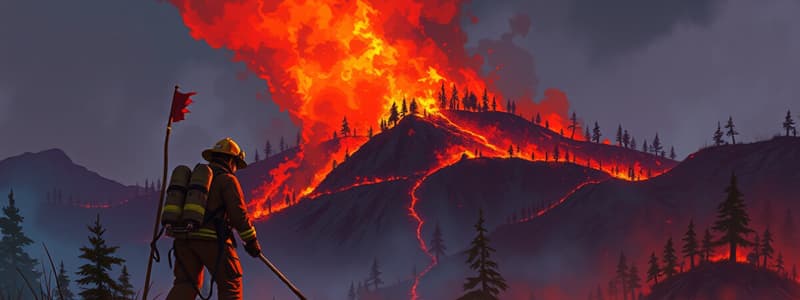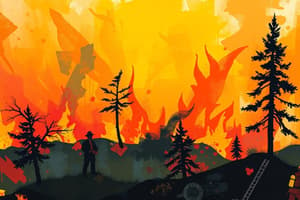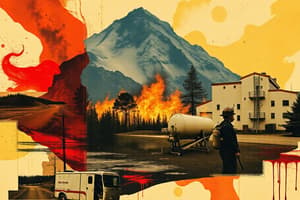Podcast
Questions and Answers
What is the primary focus of fire departments within the CALSSRC regarding wildland-urban interface fire incidents?
What is the primary focus of fire departments within the CALSSRC regarding wildland-urban interface fire incidents?
- Developing new fire suppression chemicals for urban settings
- Addressing unique fire protection challenges associated with these fires (correct)
- Increasing the number of fire hydrants in urban areas
- Expanding the wildland areas through controlled burns
How many total resources are dispatched for a first alarm urban-interface fire incident?
How many total resources are dispatched for a first alarm urban-interface fire incident?
- 18
- 35
- 21 (correct)
- 30
What designation should be used for Brush Trucks that are staffed with a 4-person crew including a Company Officer?
What designation should be used for Brush Trucks that are staffed with a 4-person crew including a Company Officer?
- Brush Crew
- Brush Unit
- Brush Squad
- Brush Engine (correct)
Which resource is NOT included in the urban-interface assignment for a brush fire incident?
Which resource is NOT included in the urban-interface assignment for a brush fire incident?
What should Company Officers report to their Battalion Chief for integration into the CAD system?
What should Company Officers report to their Battalion Chief for integration into the CAD system?
What is the required staffing for a Brush Truck on the fireground?
What is the required staffing for a Brush Truck on the fireground?
What role can a Brush Engine assume as indicated in the operational protocols?
What role can a Brush Engine assume as indicated in the operational protocols?
What is the total number of Command Officers dispatched in the first alarm urban-interface assignment?
What is the total number of Command Officers dispatched in the first alarm urban-interface assignment?
Which of the following statements accurately describes the distinction between a Brush Truck and a Brush Engine?
Which of the following statements accurately describes the distinction between a Brush Truck and a Brush Engine?
What is the total number of Tenders dispatched for an urban-interface assignment?
What is the total number of Tenders dispatched for an urban-interface assignment?
In the context of wildland-urban interface incidents, which aspect is emphasized regarding fire protection strategies?
In the context of wildland-urban interface incidents, which aspect is emphasized regarding fire protection strategies?
How many total Engines are dispatched during a first alarm urban-interface incident?
How many total Engines are dispatched during a first alarm urban-interface incident?
Which resource is included as part of the urban-interface incident assignment for the protection of the wildland-urban interface?
Which resource is included as part of the urban-interface incident assignment for the protection of the wildland-urban interface?
What is the implication of a Brush Truck being considered a tool rather than a unit?
What is the implication of a Brush Truck being considered a tool rather than a unit?
Which of the following is true about the initial reporting responsibilities of Company Officers concerning wildland-urban interface areas?
Which of the following is true about the initial reporting responsibilities of Company Officers concerning wildland-urban interface areas?
What is the role of a Shift Commander during a first alarm urban-interface incident?
What is the role of a Shift Commander during a first alarm urban-interface incident?
What should be the status of Brush Trucks on the fireground according to deployment protocols?
What should be the status of Brush Trucks on the fireground according to deployment protocols?
Which of the following resources is included in the First Alarm Urban-Interface assignment?
Which of the following resources is included in the First Alarm Urban-Interface assignment?
What is the designation of a Brush Truck staffed by a 4-person crew including a Company Officer?
What is the designation of a Brush Truck staffed by a 4-person crew including a Company Officer?
Which statement correctly describes the responsibility of Company Officers regarding wildland-urban interface fire incidents?
Which statement correctly describes the responsibility of Company Officers regarding wildland-urban interface fire incidents?
During an urban-interface incident, which command structure role is filled by the Incident Commander?
During an urban-interface incident, which command structure role is filled by the Incident Commander?
What is the minimum number of Engines required for an urban-interface assignment?
What is the minimum number of Engines required for an urban-interface assignment?
In the context of resource assignments for brush fire incidents, what does the CAD system primarily facilitate?
In the context of resource assignments for brush fire incidents, what does the CAD system primarily facilitate?
What distinguishes a Brush Truck from a traditional fire engine according to operational definitions?
What distinguishes a Brush Truck from a traditional fire engine according to operational definitions?
Flashcards are hidden until you start studying
Study Notes
Purpose and Definitions
- Establishes a standard deployment procedure for wildland-urban interface fire incidents.
- Wildland-urban interface is the transitional zone between natural land and developed areas.
Policy Overview
- Increasing concerns among Central Arizona Life Safety Response Council (CALSSRC) fire departments regarding wildland-urban interface protection.
- Emphasis on unique challenges posed by wildland-urban interface fires.
- Company Officers tasked with identifying high-risk areas within their jurisdiction for urban-interface fire incidents.
- Identified areas must be reported to Battalion Chiefs for inclusion in the Computer-Aided Dispatch (CAD) system.
Urban-Interface Assignment Resources
- Standard deployment resources for urban-interface incidents include:
- 5 Engines
- 1 Ladder
- 3 Brush Trucks
- 2 Tenders
- 2 Command Officers
- 1 Rescue (ambulance option)
- 1 Shift Commander
- 1 CXX19 (specific designation)
First Alarm Urban-Interface Resources
- Expanded deployment resources for first alarm urban-interface incidents include:
- 8 Engines
- 2 Ladders
- 5 Brush Trucks
- 4 Tenders
- 2 Rescues (ambulance option)
- 3 Command Officers
- 2 Shift Commanders
- 1 CRV (command response vehicle)
- 1 Safety Officer
- 1 Rehab sector
- 1 CXX19
Operational Information
- Some CALSSRC fire departments operate Brush Trucks with a 4-person crew, including a Company Officer.
- These Brush Trucks designated as Brush Engines in the CAD system for deployment purposes.
- Brush Engines can serve as Sector Officers as assigned by the Incident Commander.
- Brush Trucks are considered resources, not fully staffed units, and must always be supervised and supported.
- Brush Trucks cannot operate independently on the fireground without oversight.
Purpose and Definitions
- Establishes a standard deployment procedure for wildland-urban interface fire incidents.
- Wildland-urban interface is the transitional zone between natural land and developed areas.
Policy Overview
- Increasing concerns among Central Arizona Life Safety Response Council (CALSSRC) fire departments regarding wildland-urban interface protection.
- Emphasis on unique challenges posed by wildland-urban interface fires.
- Company Officers tasked with identifying high-risk areas within their jurisdiction for urban-interface fire incidents.
- Identified areas must be reported to Battalion Chiefs for inclusion in the Computer-Aided Dispatch (CAD) system.
Urban-Interface Assignment Resources
- Standard deployment resources for urban-interface incidents include:
- 5 Engines
- 1 Ladder
- 3 Brush Trucks
- 2 Tenders
- 2 Command Officers
- 1 Rescue (ambulance option)
- 1 Shift Commander
- 1 CXX19 (specific designation)
First Alarm Urban-Interface Resources
- Expanded deployment resources for first alarm urban-interface incidents include:
- 8 Engines
- 2 Ladders
- 5 Brush Trucks
- 4 Tenders
- 2 Rescues (ambulance option)
- 3 Command Officers
- 2 Shift Commanders
- 1 CRV (command response vehicle)
- 1 Safety Officer
- 1 Rehab sector
- 1 CXX19
Operational Information
- Some CALSSRC fire departments operate Brush Trucks with a 4-person crew, including a Company Officer.
- These Brush Trucks designated as Brush Engines in the CAD system for deployment purposes.
- Brush Engines can serve as Sector Officers as assigned by the Incident Commander.
- Brush Trucks are considered resources, not fully staffed units, and must always be supervised and supported.
- Brush Trucks cannot operate independently on the fireground without oversight.
Purpose and Definitions
- Establishes a standard deployment procedure for wildland-urban interface fire incidents.
- Wildland-urban interface is the transitional zone between natural land and developed areas.
Policy Overview
- Increasing concerns among Central Arizona Life Safety Response Council (CALSSRC) fire departments regarding wildland-urban interface protection.
- Emphasis on unique challenges posed by wildland-urban interface fires.
- Company Officers tasked with identifying high-risk areas within their jurisdiction for urban-interface fire incidents.
- Identified areas must be reported to Battalion Chiefs for inclusion in the Computer-Aided Dispatch (CAD) system.
Urban-Interface Assignment Resources
- Standard deployment resources for urban-interface incidents include:
- 5 Engines
- 1 Ladder
- 3 Brush Trucks
- 2 Tenders
- 2 Command Officers
- 1 Rescue (ambulance option)
- 1 Shift Commander
- 1 CXX19 (specific designation)
First Alarm Urban-Interface Resources
- Expanded deployment resources for first alarm urban-interface incidents include:
- 8 Engines
- 2 Ladders
- 5 Brush Trucks
- 4 Tenders
- 2 Rescues (ambulance option)
- 3 Command Officers
- 2 Shift Commanders
- 1 CRV (command response vehicle)
- 1 Safety Officer
- 1 Rehab sector
- 1 CXX19
Operational Information
- Some CALSSRC fire departments operate Brush Trucks with a 4-person crew, including a Company Officer.
- These Brush Trucks designated as Brush Engines in the CAD system for deployment purposes.
- Brush Engines can serve as Sector Officers as assigned by the Incident Commander.
- Brush Trucks are considered resources, not fully staffed units, and must always be supervised and supported.
- Brush Trucks cannot operate independently on the fireground without oversight.
Studying That Suits You
Use AI to generate personalized quizzes and flashcards to suit your learning preferences.




